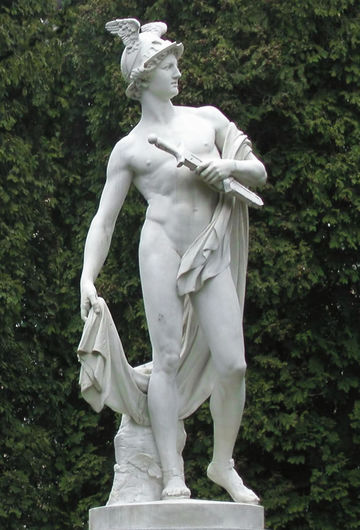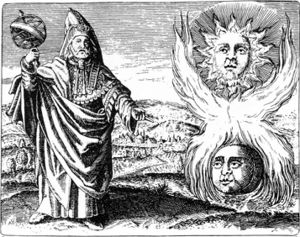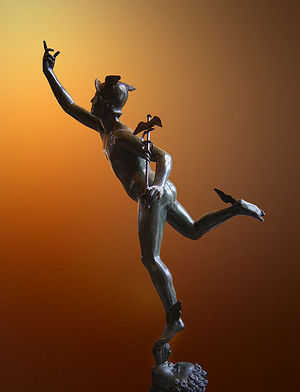Hermes Trismegistus/pt: Difference between revisions
(Created page with "Um autor antigo, que afirmou ter visto a placa, disse que era uma esmeralda onde os caráteres eram representados em baixo relevo e não gravados. Inicialmente, o material enc...") |
(Created page with "Nas escolas de mistérios, durante muito tempo, a placa de esmeralda foi considerada uma das mais antigas e profundas revelações da alquimia espiritual. Ela apresenta um...") |
||
| Line 35: | Line 35: | ||
encontrava-se em estado fluido, como vidro derretido, mas fora lançado em um molde e adquirira a dureza de uma esmeralda genuína por meios alquímicos. | encontrava-se em estado fluido, como vidro derretido, mas fora lançado em um molde e adquirira a dureza de uma esmeralda genuína por meios alquímicos. | ||
Nas escolas de mistérios, durante muito tempo, a [[placa de esmeralda]] foi considerada uma das mais antigas e profundas revelações da alquimia espiritual. Ela apresenta uma fórmula alquímica que, há milhares de anos, tem sido usada por adeptos e alquimistas para assimilar a compreensão mais essencial da transmutação física e da regeneração espiritual. Entretanto, as inscrições escondem de todos, exceto do verdadeiro alquimista, o seu significado interior. | |||
The ascended master Hermes has taught of the emerald tablet of the heart: | The ascended master Hermes has taught of the emerald tablet of the heart: | ||
Revision as of 22:36, 9 May 2020

Na antiguidade, Hermes era conhecido como o grande sábio, a quem foram atribuídos textos sagrados e trabalhos alquímicos e astrológicos. Devido ao seu conhecimento e profundo talento nas artes e nas ciências, os egípcios deram-lhe o nome de Trismegisto, que significa três vezes grande. O título também se aplica ao seu papel como filósofo, sacerdote e rei.
O Mestre Ascenso Hermes Trismegisto também é conhecido como Deus Mercúrio. Hermes andou pela Terra por dezenas de milhares de anos. Esteve na Atlântida, caminhou nas suas ruas, frequentou templos e salas de estudo, e transmitiu os seus ensinamentos. Hermes figura como o grande arquétipo do mensageiro dos deuses.
No livro History of Chemistry, James Campbell Brown escreveu:
Uma série de antigos livros egípcios é atribuída a Hermes Trismegisto, que pode ter sido um sábio autêntico ou, talvez, a personificação de uma longa sucessão de escritores. Alguns identificam-no com o deus grego Hermes, que corresponde ao deus romano Mercúrio e ao deus egípcio Thoth. Os egípcios consideravam-no o deus da sabedoria, das letras e do registro do tempo”.[1]
Registro histórico
Até o século dezessete, pensava-se que Hermes era contemporâneo de Moisés. Seus escritos foram considerados pelos cristãos quase tão sagrados quanto a Bíblia. O padre Justino Mártir da igreja chegou ao ponto de compará-lo a Jesus. O padre Clemente de Alexandria, da Igreja Grega, falou de quarenta e dois "livros de Thoth" que tratavam de educação sacerdotal, ritual do templo, geografia, astrologia, orientação para reis, hinos aos deuses e medicina. Lamentavelmente, eles foram perdidos na queima da biblioteca de Alexandria.
Os estudiosos de hoje nos dizem que Hermes era um sábio egípcio antigo, ou talvez uma sucessão de sábios. Eles acreditam que toda uma linhagem de professores ou sacerdócio pode ter escrito sob o nome Hermes. A teoria predominante é que os escritos herméticos podem abranger vários séculos, datando até o primeiro ou segundo século A.D..
Segundo um historiador egípcio antigo, Hermes escreveu 36.525 livros. Seus assuntos incluíam alquimia, astrologia e teologia. Ele era considerado o guardião da sabedoria e da literatura. Para esclarecer o povo, Hermes teve suas instruções gravadas em hieróglifos sobre mesas ou colunas de pedra em todo o Egito.
Alguns colocaram Hermes no período anterior ao Dilúvio. O arqueólogo James Churchward registra Thoth nos dias da Atlântida. Os egípcios honraram Thoth como o deus da sabedoria, aprendizado e literatura. Eles o viam como o inventor de todas as artes e ciências, incluindo escrita, aritmética, álgebra, geometria, teologia, economia política, medicina, cirurgia, música e instrumentos musicais. Ele era considerado o escriba dos deuses.
Scholar Hargrave Jennings writes:
Diz-se que outro Thoth, ou Hermes, viveu em um período posterior. Ele foi igualmente celebrado com o primeiro, e para ele é particularmente apropriado, por alguns, pelo nome de Trismegisto. Segundo Manetho [um sacerdote e historiador egípcio c. 300 B . C .], Ele [este segundo Thoth] traduziu de tábuas de pedra gravadas, que haviam sido enterradas na terra, os caracteres sagrados dos primeiros Hermes. Ele escreveu a explicação deles em livros, que foram depositados nos templos egípcios. Hargrave Jennings, "The Divine Pymander of Hermes Mercurius Trismegistus" (San Diego, Califórnia: Wizards Bookshelf, 1985), pp. Iii , iv, v. </ref>

O tablete esmeralda
Hermes Trismegisto ficou conhecido como o pai da alquimia. Segundo uma lenda, em uma placa de esmeralda encontrada no seu túmulo havia inscrições dos seus preceitos para fazer ouro. A placa continha o famoso axioma hermético: “O que está embaixo é igual ao que está em cima. E o que está em cima é igual ao que está embaixo”.176.[2]
Um autor antigo, que afirmou ter visto a placa, disse que era uma esmeralda onde os caráteres eram representados em baixo relevo e não gravados. Inicialmente, o material encontrava-se em estado fluido, como vidro derretido, mas fora lançado em um molde e adquirira a dureza de uma esmeralda genuína por meios alquímicos.
Nas escolas de mistérios, durante muito tempo, a placa de esmeralda foi considerada uma das mais antigas e profundas revelações da alquimia espiritual. Ela apresenta uma fórmula alquímica que, há milhares de anos, tem sido usada por adeptos e alquimistas para assimilar a compreensão mais essencial da transmutação física e da regeneração espiritual. Entretanto, as inscrições escondem de todos, exceto do verdadeiro alquimista, o seu significado interior.
The ascended master Hermes has taught of the emerald tablet of the heart:
I, Hermes, messenger of the Gods and also the one called Mercury, have tarried, lo, these tens of thousands of years and beyond that there might be a torch of remembrance, an inscribing of the Law upon the emerald tablet of thy heart.
For, lo, the emerald tablet in the secret chamber of thy heart is even now unveiled by thine own Holy Christ Self, the priest-philosopher-scientist who officiates at the altar of unalterable change. It is that change that must come, that must be because I AM and because thou art also the God-man.
He instructed us to
... neglect not the heart; and call the sacred fire to melt and transmute daily all hardness of heart, spiritual neglect and records of death surrounding the sun center of your own heart chakra. Let us be diligent to expand the heart, for out of it are the issues of life.[3]
The Hermetic tradition
The Hermetic tradition teaches that it is through mystical experience that man attains liberation. Scholar Sidney Spencer writes:
The Hermetic mystic sees his unity with all beings. The purgation and illumination of the soul which he attains brings him the consciousness of universal fellowship, and it is his task to do good to all.[4]
In the Mahatma Letters the Master K.H. praises Hermetic philosophy:
Hermetic Philosophy suits every creed and philosophy and clashes with none. It is the boundless ocean of Truth, the central point whither flows and wherein meet every river, whether its source be in the East, West, North, or South. As the course of the river depends upon the nature of its basin, so the channel for the communication of Knowledge must conform itself to surrounding circumstances. The Egyptian Hierophant, the Chaldean Mage, the Arhat, and the Rishi, were bound in days of yore on the same voyage of discovery and ultimately arrived at the same goal though by different tracks.[5]
According to scholar Walter Scott, some of the Hermetic texts may have been written down by the pupils of Ammonius Saccas, a renowned third-century Alexandrian teacher and one of the founders of the Neoplatonic movement. He was a teacher of Origen. Helena Blavatsky considered that the most important goal of the Theosophical Society was to revive the work of Ammonius Saccas. Blavatsky wrote:
It was Ammonius who first taught that every religion was based on one and the same truth; which is the wisdom found in the Books of Thoth (Hermes Trismegistus), from which books Pythagoras and Plato had learned all their philosophy.[6]
Today, fewer than twenty sermons and some additional fragments of Hermes’ teachings remain. In 1945 three Hermetic tracts were discovered at Nag Hammadi, thus indicating a link between the Gnostic and Hermetic schools. The Gnostics, who flourished in the second century A.D., believed that the most important element in the soul’s spiritual quest was gnosis—a Greek word meaning “knowledge.” We see this same principle reflected in the Hermetic teachings. Scholar Giovanni Filoramo says:
The Hermes texts were written in the form of gentle scholarly dialogues in which Hermes teaches a closed group of disciples. They are imbued with an irrepressible desire for knowledge of God. Their ideological structure is an attitude of genuine, deep devotion as the way to knowledge of oneself and of God.[7]
The lineage of the planet Mercury
The ascended master Hermes is the sponsor of El Morya and of all those who have come from the planet Mercury. El Morya explains:
The lifewaves of sons and daughters of God who have evolved out of Mercury, who have served with Sanat Kumara and who now are dwelling on earth, come from an evolution that we knew long ago. In that planetary body, the issue of light and darkness was present....
As we saw the challenge and as we were taught by God Mercury, we knew that unflinching devotion to the will of God, the drawing within of energy to the diamond point of the Self, the wielding of the sword of blue flame, and the mastery of the action of fohatic keys would result in the victory....
God gave to us, as we fought the battle of worlds on Mercury, that energy, that power—only because we were willing to balance the threefold flame, to pursue wisdom and wisdom’s might, to intensify such love in every cell and in the flame of every cell, so that our auras were so saturated with love that there was no possibility for the misqualification of one erg of God’s power through any form of tyranny whatsoever....
Beloved ones, the victory of Mercury has not yet been concluded. A greater part of the victory was won, yet certain sons of light and certain fallen ones had not reached the culmination of their evolution. They were, therefore, assigned to other planetary homes and systems. Some of the fallen ones became aligned with the laggard evolutions that eventually embodied on earth. Some of the sons and daughters of God journeyed to Venus and later accompanied Sanat Kumara to earth.[8]

The arts of communication
Hermes calls those who would take up the arts of communication in defense of Truth:
I am a messenger of the Gods and I have a message that I must deliver to your hearts....
I speak of the lineage of the initiates of Mercury—those who have fashioned their skill by the sword and the pen, those who have acquainted themselves with the mind of God and have claimed that mind, who have come from a lineage that antedates myself. Truly, there is a lineage of those who have been called Hermes, the name being the title of an office. Thus, there is a descent of those whose craft has been to set forth in writing and in other forms of communication that which is Real, that which is unreal, that which is necessary information to the body politic round the world that they might know and understand the way to go....
There are those whom I myself have trained under my mantle as God Mercury. We who bear the shield and the armour of the Sun must therefore go up and down the nations of the earth and call out those who have the original communication skills, who practiced those skills in ancient times and on ancient continents and are willing to once again take the lead in the dissemination of the Truth and in exposing error. You must come forward! For the Truth must be made known....
Set forth the message! Set forth the platform for its delivery in your area of expertise! And if you think you have no expertise, go out and get it, and study and prove yourself to be one who will make that statement and make that name, not only for yourself but for God and all the ascending ones. I AM Hermes and I say to you: I shall overshadow any of you, each and every one of you, who will learn these disciplines.[9]
His service today
At the present time, Hermes serves in the retreat in Arabia where he is the patron of the science of alchemy—which Saint Germain has defined as the all-chemistry of God. His aura is a brilliant gold; he wears white robes and has long hair. He is the image of the ancient wisdom and the androgynous nature of the Deity.
See also
For more information
MP3 audio album Emerald Matrix: The Perfect Light includes a lecture on Hermes and a dictation by him.
Sources
Mark L. Prophet and Elizabeth Clare Prophet, The Masters and Their Retreats, s.v. “Hermes Trismegistus (God Mercury).”
- ↑ James Campbell Brown, A History of Chemistry from the Earliest Times till the Present Day London: J.& A. Churchill, 1913.
- ↑ Hargrave Jennings, The Divine Pymander of Hermes Mercurius Trismegistus San Diego, Califórnia. Wizards Bookshelf, 1985, p. x.
- ↑ Hermes Mercurius Trismegistus, “The Emerald Tablet of the Heart,” Pearls of Wisdom, vol. 24, no. 73, August 1981.
- ↑ Sidney Spencer, Mysticism in Religion (London: Allen & Unwin, 1966), p. 147.
- ↑ The Mahatma Letters to A. P. Sinnett, compiled by A. T. Barker (Theosophical University Press, 1926), letter 85.
- ↑ H. P. Blavatsky, Isis Unveiled (Wheaton, Ill.: Theosophical Publishing House, 1972), vol. 1, p. 444.
- ↑ Giovanni Filoramo, History of Gnosticism.
- ↑ El Morya, “The Gemini Mind: For the Governing of Society and the Self,” Pearls of Wisdom, vol. 24, no. 43, October 25, 1981.
- ↑ Hermes Trismegistus, “The Guild of God Mercury: The Sword and the Pen,” Pearls of Wisdom, vol. 36, no. 42, September 22, 1993.
